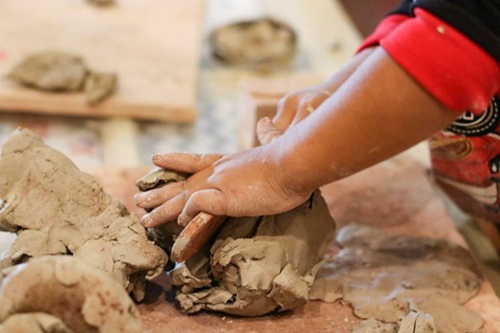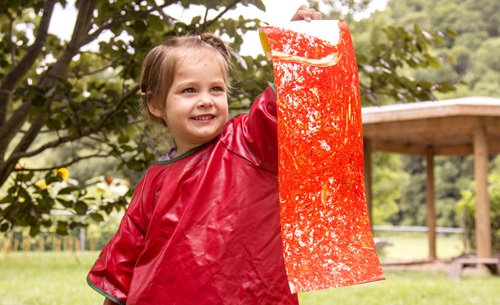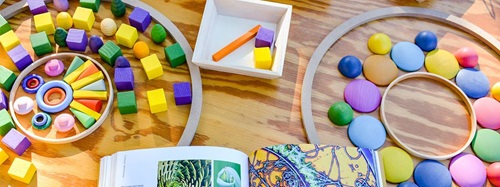Creating a Makerspace in Your Classroom
| August 2022As inherently curious human beings, children love to explore with their senses. They are natural makers and creators. Many popular early childhood approaches seek to incorporate experiences with hands-on and natural materials to enhance children’s learning. One of these approaches, “The Maker Movement” started as a social phenomenon in the early 21st century. The Maker Movement has sought to introduce science, technology, engineering, arts, and mathematics (STEAM) into educational settings at all levels. “Makerspaces” have popped up in schools and classrooms across the country, oftentimes at great expense. However, incorporating “making” into your curriculum does not necessarily mean you need a large budget to purchase technology, equipment, or other materials.
What is Making?
Let’s pause a moment and define what we are talking about when we use the term “making”. According to The National Association for the Education of Young Children (NAEYC) “tinkering” can be defined as “doing stuff”. Children randomly exploring with a variety of materials are “tinkering”. NAEYC defines “making” as creating something from an idea—something from the imagination that is being brought to life. And finally, NAEYC defines “engineering” as adding external constraints to the “making” process—the creation “does stuff” or solves a problem, like creating a bridge out of blocks for toy cars to go across.
The Goal of Maker-Centered Learning
So, if children are already imagining, making, and creating, why should we care about infusing those experiences with STEAM activities and concepts? Well, there are a number of evidence-based reasons to do this!
Right from the start children are building their identity and capability.
From birth children are building their self-concept of who they are and what they are capable of doing. Introducing young people, particularly girls and black/brown children to STEAM activities at this age helps them build what some researchers call “STEM-possible selves”. Making at this early age opens up possibilities and opportunities for them as they get older that research shows they may not have otherwise.
Children are imaginative world builders who thrive with concrete examples.
Just as children learn through social interactions and language, they also learn through what Piaget protégé, Seymour Papert, has called “constructionism”. Building physical objects, especially those that are intended to be shared, helps children construct knowledge of physics, math, and science, etc. Making also provides many opportunities for children to learn to collaborate and communicate throughout the process of creation. During that process of making and collaborating, creativity is fostered and developed. A sense of agency and leadership is developed as students offer suggestions and experiment with the suggestions of others.
Experimentation is a problem-solving, social-emotional learning bonanza!
While exploring the natural and manufactured designs in their world, children develop a sense of reflection and personal perspective. Children create opportunities to use executive functions while working to develop their ideas. Opportunities to make a plan, test it out, and see how it went. Through making, children gain an understanding of the world as a place that has been designed and therefore something that can be changed and is malleable.
Teachers and other adults also have the exciting ability to learn how capable and creative children will be when they are encouraged to look closely at their world, wonder how things work and why things exist. This helps social emotional skills blossom as the young makers and their adult counterparts begin to recognize each other as equals and valuable.
Making is grounded in a process of iterative design. Prototypes are made and improved on over and over again, thereby giving children lots of opportunity to practice having a growth mindset. Developing a growth mindset at an early age powerfully impacts their approach to learning as they move on to later stages of development where product becomes more important than process in learning.
Setting up the Environment for Making
Maker-centered learning does not require purchasing expensive equipment. You will, however, need to be intentional in how you set up the environment. How you create your classroom spaces and how you display projects and materials helps to spur on the “making” in your classroom.
Seating and Spaces:
- Having a large low table with a variety of seating options such as stools, chairs, and space to stand allows students to comfortably work on projects. Their proximity to each other as they create allows them to gain ideas and collaborate together with ease.
- Having a round rug in the classroom lets students see each other’s projects and faces as they share what they have created or while discussing project ideas.
- And finally, it’s important for students to have a quiet nook or corner filled with comfortable pillows, books, and beautiful objects to look at because making can be a boisterous and exciting activity that some children may need to take a break from in order to recharge.
Organization and Displays:
- Having low, accessible shelves with materials organized in labeled containers or bins gives students agency over their making and sparks creativity. Making materials should be easily accessible to children.
- Displaying students’ creations around the classroom on the walls and shelves offers examples of projects that students might want to try themselves. It’s important, though, that these displays contain not just finished project, but plans and prototypes so that makers can receive feedback and help with their designs.
Examples of Making in the ECE Classroom
While making in the ECE classroom can look like everything from a large, multi-faceted project to a simple making station where the tools exist for the children to explore; one aspect that is key. However you introduce making in your classroom or curriculum, it must be child driven.
Maker Stations
We have found that maker stations are the best way for teachers to first explore making in their classroom. A maker station can be as simple as a few open-ended objects offered to students with the intent that they can be utilized however the student wishes them to be. This may mean the flexibility of combining multiple objects to design a new one or using objects in different centers. Flexibility in following the children’s interest and lead in designing a maker station is key to its success.
Maker Spaces
Educators may find that the children have a continued interest in the objects offered in a maker station and may want to designate a part of their classroom to open-ended exploration. The key difference here is that the learning objective switches from a focus on the objects and their interplay with the environment toward seeing how objects chosen by children interplay with one another.
Maker Projects
Projects arise out of children’s curiosity and often take over the entire classroom. Here, educators can follow the inquiry that came out of a certain interest in either a station or space and expand the children’s inquiry to deepen their learning. A few successful examples of stations or spaces that grew into projects were studying insects, magnets, and 3D shapes. Often, documentation from these types of projects is rich in photos and experiences showcasing both the children’s and the educator’s inquiry and learning experiences.
We hope that you will now feel more excited and empowered to start making in your classroom today! Our goal is for everyone to see themselves as a change maker and a leader, especially when it comes to helping children explore their curious questions and discover the designed world all around us. Please visit us at https://www.cradle2college.com/ for more resources and tips. And, definitely let us know about your projects and questions going forward!
References:
Clapp, E. P., Solis, S. L., Ho, C. K. N., and Laguzza. 2020 Maker-Centered Learning Playbook for Early Childhood Education. Cambridge, MA. Makercentered Learning Playbook for Early Childhood Education”
National Association for the Education of Young Children (NAEYC)











